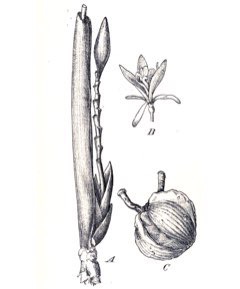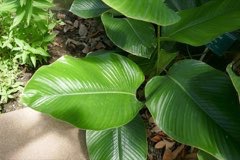 |
|
http://www.edibleplants.org |
 |
| Ji-Elle wikimedia.org |
Translate this page:
Summary
Thaumatococcus daniellii, otherwise known as Sweet Prayer Plant, is native to western part of Africa, from Sierra Leone to Zaire. It is a large flowering herb with rhizomatous rootstock, growing about 4 m in height. It is a natural source of thaumatin, a low-calorie sweetener and flavor modifier protein. The leaves are ovateelliptic, large, and papery. The flowers are purple which occur singly or in branched spikes. The fruits are covered in a fleshy red aril, trigonal in shape and dark red/brown when fully ripe. Each fruit contains three black, hard seeds which can be eaten raw or cooked. It can also be used as sweetener. The leaves, on the other hand, are used for wrapping foods and for boiling foods. Petiole is used as weaving materials for mats and as tools and building materials. Leaves area also used for roofing. T. daniellii is also used in traditional medicine as a laxative (fruits), as an emetic and for pulmonary conditions (seeds), as antidote against venoms, stings, and bites (leaf sap), and as sedative and for insanity treatment (leaf and root sap).
Physical Characteristics

 Thaumatococcus daniellii is an evergreen Perennial growing to 2 m (6ft) by 2 m (6ft) at a fast rate.
Thaumatococcus daniellii is an evergreen Perennial growing to 2 m (6ft) by 2 m (6ft) at a fast rate.
See above for USDA hardiness. It is hardy to UK zone 10.
Suitable for: medium (loamy) and heavy (clay) soils and prefers well-drained soil. Suitable pH: mildly acid and neutral soils and can grow in very acid soils.
It can grow in full shade (deep woodland) semi-shade (light woodland) or no shade. It prefers moist soil.
UK Hardiness Map
US Hardiness Map
Synonyms
Donax daniellii (Benn.) Roberty Monostiche daniellii (Benn.) Horan. Phrynium daniellii Benn.
Plant Habitats
Edible Uses
Edible Parts: Leaves Seed
Edible Uses: Sweetener
Seed - raw or cooked. A very sweet flavour[301 ]. When the raw seed is chewed, it affects the taste buds so that, for about an hour thereafter, any sour foods that are eaten or drunk seem to have a sweet flavour[301 ]. The seeds are also used for sweetening bread, fruits, tea etc[301 ]. The aril of the seed contains a sweet-tasting protein (thaumatin) that can be used as a substitute for sugar, also in low caloric diets and drinks[310 ]. Because of the persistent sweet aftertaste, it also 'sweetens' normally bitter or sour substances[310 ]. Thaumatin is the sweetest of known natural and synthetic substances, 2,000 - 3,000 times sweeter than sucrose[310 ]. The leaves are used for wrapping food[418 ]. The report does not make it clear if the leaves are used to impart a flavour when cooking, or are merely used to wrap the food when it is stored[K ].
References More on Edible Uses
Medicinal Uses
Plants For A Future can not take any responsibility for any adverse effects from the use of plants. Always seek advice from a professional before using a plant medicinally.
None known
References More on Medicinal Uses
The Bookshop: Edible Plant Books
Our Latest books on Perennial Plants For Food Forests and Permaculture Gardens in paperback or digital formats.

Edible Tropical Plants
Food Forest Plants for Hotter Conditions: 250+ Plants For Tropical Food Forests & Permaculture Gardens.
More

Edible Temperate Plants
Plants for Your Food Forest: 500 Plants for Temperate Food Forests & Permaculture Gardens.
More

More Books
PFAF have eight books available in paperback and digital formats. Browse the shop for more information.
Shop Now
Other Uses
Containers Packing Roofing
Other Uses: The leaves are used as food wrappers, as a packing material and for roofing[301 , 310 ].
Special Uses
References More on Other Uses
Cultivation details
A plant of the moist, lowland tropics. It grows best in areas where annual daytime temperatures are within the range 21 - 30°c, but can tolerate 15 - 35°c[418 ]. It prefers a mean annual rainfall in the range 1,700 - 2,300mm, but tolerates 1,300 - 2,700mm[418 ]. Requires a shady position[310 ]. Plants can succeed in full sun as well as it shade[418 ]. Prefers a well-drained, loamy to clayey soil[418 ]. Prefers a pH in the range 4.5 - 5, tolerating 4.3 - 7[418 ]. First flowering starts 3 months after planting, but flowering is more abundant after about 1 year[310 ]. Good fruits develop only in plants that are 2 years old or older[310 ]. Young fruits mature in 13 weeks[310 ].
References Carbon Farming Information and Carbon Sequestration Information
Temperature Converter
Type a value in the Celsius field to convert the value to Fahrenheit:
Fahrenheit:
The PFAF Bookshop
Plants For A Future have a number of books available in paperback and digital form. Book titles include Edible Plants, Edible Perennials, Edible Trees,Edible Shrubs, Woodland Gardening, and Temperate Food Forest Plants. Our new book is Food Forest Plants For Hotter Conditions (Tropical and Sub-Tropical).
Shop Now
Plant Propagation
Seed - Rhizome cuttings.
Other Names
If available other names are mentioned here
Abieba, Etere, Katamfe, Katemfe, Lokongo, Ngongo, Nzilizili, Sweet prayer, ewe eran, ewe moi-moi, katamfe, miraculous fruit.
Native Range
AFRICA: Cameroon, Congo, Gabon, Sao Tome and Principe, Côte D‘Ivoire, Ghana, Liberia, Nigeria, Togo
Weed Potential
Right plant wrong place. We are currently updating this section.
Please note that a plant may be invasive in one area but may not in your area so it's worth checking.
Conservation Status
IUCN Red List of Threatened Plants Status : This taxon has not yet been assessed

Growth: S = slow M = medium F = fast. Soil: L = light (sandy) M = medium H = heavy (clay). pH: A = acid N = neutral B = basic (alkaline). Shade: F = full shade S = semi-shade N = no shade. Moisture: D = dry M = Moist We = wet Wa = water.
Now available:
Food Forest Plants for Mediterranean Conditions
350+ Perennial Plants For Mediterranean and Drier Food Forests and Permaculture Gardens.
[Paperback and eBook]
This is the third in Plants For A Future's series of plant guides for food forests tailored to
specific climate zones. Following volumes on temperate and tropical ecosystems, this book focuses
on species suited to Mediterranean conditions—regions with hot, dry summers and cool, wet winters,
often facing the added challenge of climate change.
Read More
Expert comment
Author
(Benn.) Benth. ex B.D.Jacks.
Botanical References
Links / References
For a list of references used on this page please go here
A special thanks to Ken Fern for some of the information used on this page.
Readers comment
| Add a comment |
|
If you have important information about this plant that may help other users please add a comment or link below. Only comments or links that are felt to be directly relevant to a plant will be included. If you think a comment/link or information contained on this page is inaccurate or misleading we would welcome your feedback at [email protected]. If you have questions about a plant please use the Forum on this website as we do not have the resources to answer questions ourselves.
* Please note: the comments by website users are not necessarily those held by PFAF and may give misleading or inaccurate information.
To leave a comment please Register or login here All comments need to be approved so will not appear immediately.
|
Subject : Thaumatococcus daniellii
|
|
|
|